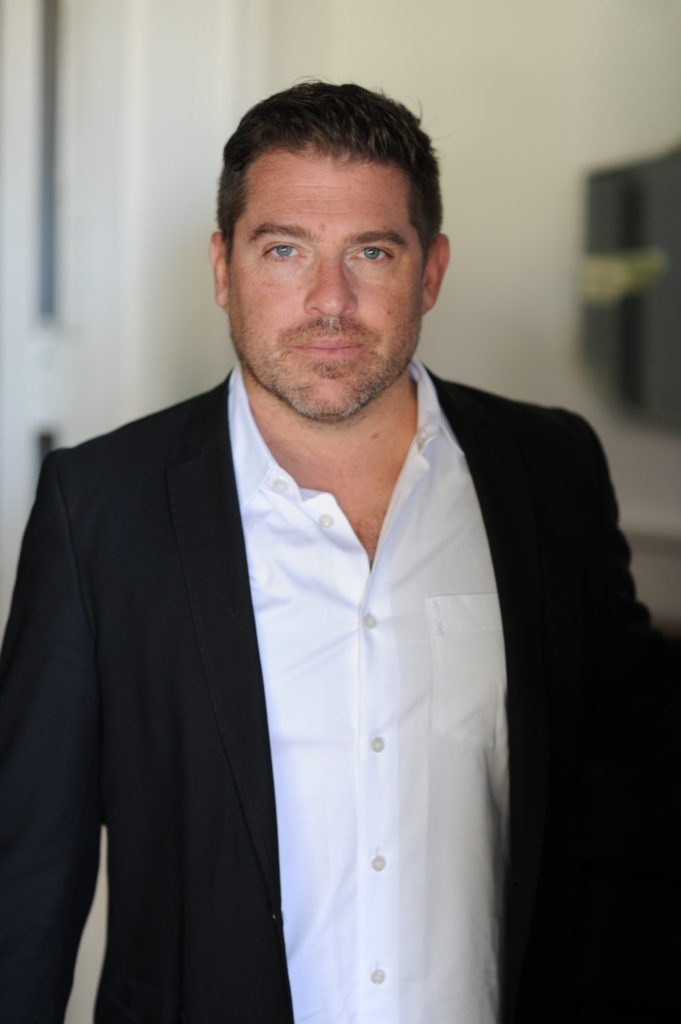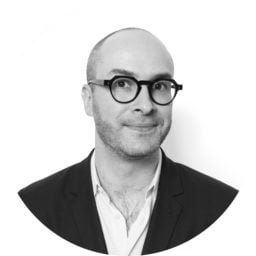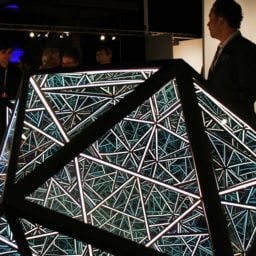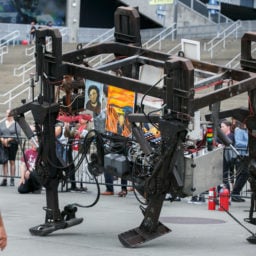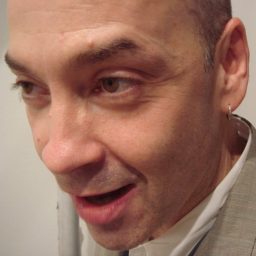Nato Thompson has a knack for putting artists and other thinkers together in a way that gets people talking. He did this to great effect during his decade at the New York nonprofit Creative Time, where he organized the annual Creative Time Summit—a freewheeling marathon of accessibly formatted art talks with a social-practice bent—and also managed such celebrated projects as Kara Walker’s giant sugar installation A Subtlety in 2014. Now, as the new artistic director of the Seattle Art Fair, Thompson has been tasked with recreating this same kind of engaging, civic-minded discussion around art, only in a city far removed from the slipstream of the in-the-know art world. And, also, within the generally antiseptic context of an art fair. It’s a challenge.
Thompson, luckily, is the right guy for the job—if only because the way he approaches art is less through think-y books of criticism (although he has written two, Seeing Power and Culture as a Weapon) and more as something that, when done right, can be intuitively grasped by the man or woman on the street.
For his first edition of the fair’s programming, he tapped the celebrated artist Trevor Paglen to present a mylar inflatable satellite that will later be launched into the cosmos and, on that same wow-inducing theme, brought in Chris Burden’s 1983 Scale Model of the Solar System, which starts in Gagosian’s booth and stretches almost a mile to the Seattle Art Museum. Thompson has also invited Mark Pauline, the increasingly famous robot-maker behind Survival Research Laboratories, to participate in the programming, along with such local artists as the Anishinaabe performance duo Charlene Vickers and Maria Hupfield.
To learn more about the ideas driving Thompson’s debut, artnet News’s Andrew Goldstein spoke to the curator—who since last fall has taken on a new full-time gig as the artistic director of the new Philadelphia Contemporary museum—about how he’s approaching the fair.
Everybody’s interested in two topics that converge in what you’re doing. One of them is art/tech intersection and how to find a common language to connect them, and the other is how fairs can innovate and offer more for the galleries and the art scenes that they serve. On top of that, you’re approaching these questions from an unusual perspective in that you come from the nonprofit public-art world, working for years at Creative Time. To begin, how did you find yourself in the position of working with a Seattle art fair?
It’s pretty simple in the sense that I got a call and they said, “Would you be interested in being an art director for the fair?” And I was like, “I don’t know.” I get a lot of calls for a lot of things, but I certainly don’t get calls like that. I’ve done things for Art Basel Miami a few times, but this kind of job is entirely new for me. And I was interested in it. I don’t really work in the commercial realm at all. But this is very similar to what I’ve always done, which is put to together talks and organize projects. I feel like it’s the same old job description, but certainly on a different platform. And the prospect of doing it in Seattle really intrigued me too. I just took on this job in Philadelphia starting a new museum with Harry Philbrick and I’m very invested in what it means to build art ecologies in cities that are not big metropolises like LA, Chicago, and New York.
This fair was founded by Paul Allen, the Silicon Valley billionaire. Do you know what the kernel of insight was that led him to start an art fair in Seattle?
Well, I would not be the one to speak for Paul Allen, but I can say that it’s very clear that he has myriad interests. My God—it ranges from coral reefs to outer space to trying to get new film production and concert series off the ground. He’s also very interested in the arts and wants to bring it back to Seattle, but any any nuance beyond that I do not know. I know at the fair there is a deep interest in getting the visual contemporary art scene and the collector circle growing in the city. It’s a basic need, and an obvious one.
New York takes its art scene for granted, but there aren’t many giant collectors on the West Coast—particularly on the Northwest Coast—and it takes more nurturing. It’s also far, to make a simple point. It’s far from New York.
It’s far from LA, even—it’s definitely outside the traditional art circuit. So, how do you think of the audience there? Do you have a little pie chart in your head of the constituent kinds of populations to address?
I’m not that scientific—I kind of just do what I always do. Like at Creative Time, I’ve geared it toward a populist public. I’m interested in the kind of art that you don’t need to know “art” to appreciate, so I try to avoid any kind of hermetic stuff or anything overwrought with art-historical info.
I like it when you can grasp it immediately and then it gets deeper and deeper as you dive in—anything from robots to satellites to really fun films about gentrifying cities. You know when you see art that reminds you, “Oh yeah, I do like art”? It’s not something that happens all the time, but it’s a straightforward experience—it isn’t hard. I try to produce things like that, because certainly we all know the alienated feeling of, “Um, I’ve been in the art world forever and I still don’t know what’s going on.”
Art fairs, believe it or not, are not the best place to get your art education from, because it’s a really complex formula, with so many galleries coming at art from such different perspectives. There’s no thread to connect it all. So for a newcomer, it can be very overwhelming. Even for experienced people, it’s overwhelming. It’s not like a monographic exhibition where there’s didactic material that will walk you through the show. It’s complete chaos. Over time, you get to enjoy it. But it takes a while to figure out what’s going on.
And so, when I think about the Seattle audience, I know that a lot of the public comes to the fair, and I want to make sure that they can grasp onto something. That’s why I went with the tech thing—not just because it’s interesting, but also to hit the Seattle vibe a little bit.
I really like the way you talk about art that you don’t need to understand “art” to appreciate, but it’s tricky because that can privilege the most superficial parts of the art experience. Just like there are surely many people who will walk through the art fair looking for a painting that will match the colors of their living room décor, there are people who will come and see a giant robot shooting flames out of it and view that as pure entertainment. How do you balance that?
I have no problem with being entertaining, but my hope is that there’s a little bit more depth than that. We’re working with these two Anishinaabe artists, Maria Hupfield and Charlene Vickers, and they have these historical, ritualistic performances that use large eyepieces and bullhorns to converse with the past, and while you would never call those things “tech,” in essence, it is tech, as these kinds of prostheses for the body. I also found it interesting that they use these to communicate with the past, when the more traditional “Western” approach is to communicate with the future. So, I try to think through this whole tech thing in a more complex way. Obviously it’s mildly dystopic, but hey.
At the moment, one thing that strikes me as interesting is that often the groundbreaking art is not being made by the smart kids who go to the best art schools and then sign up with the cool gallery, but rather by people who have a foot in a different field and are using art as a form of rhetoric to get across, in a left-handed way, some kind of message they couldn’t otherwise. I’m thinking of the filmmaker Alejandro González Iñárritu’s virtual-reality migrant experience Carne y Arena, for instance.
I’ve always been of that opinion. It’s why I’m into the interdisciplinary in a radical way. [At the Seattle fair], we’ve got Mark Pauline, the robot-maker, who’s been doing this stuff for a long time, but really was never in the contemporary art world. He kind of avoided it as much as he could. So we have him in conversation with Bruce Sterling, the science fiction writer. I’m interested in these crossovers, trying to get to the spaces where different fields are colliding. Then we also have Heather Dewey-Hagborg’s project in collaboration with Chelsea Manning. These are people who are not using the discourse of art because they think it’s nifty, but because they have general interests that are relevant to our lives right now. I find that that approach refreshing.
Where do you think the relationship between the art world and the tech world stands today?
Let’s face it, it’s weird—over the years I’ve seen art and tech’s relationship come into vogue and then fade out again. Like in ’97, kind of dot-com phase one, art and tech rose up, and then it kind of faded. Now we’re in social media round two, and it’s all over the place. You can’t get tech out of art right now, from virtual reality to biotech to space exploration to design firms that are doing projects with galleries. And like everything that generates a lot of excitement around it, there’s the good, the bad, and the ugly. You just have to have a discerning eye.
The pitfall of art and tech can always be the fetishization of the toys themselves. But one of the benefits is that you can actually think about the world in a profoundly different way. I mean, at this point, you can’t ignore your phone. And I feel deeply connected to my Sony Playstation 4. Will Arnett, the actor, said something funny on NPR, that “the problem with having kids is they want to play your video games.” I have a four-and-a-half-year-old and he’s always like, “What’s that?” And I say, “It’s nothing. That’s daddy’s. That’s an adult toy.”
Well, I guess you can just hand off your iPhone and then problem solved.
I’m very sensitive to that. I am very cautious about screen time and kids and all the neurological things that happen. The pace that it sets the mind to is really hard to undo.
So, what do you want to get out of your first edition of the fair’s programming?
I just want it to be exciting and interesting and complex, and also I want it to be a success for the people in Seattle and the artists involved. I feel like it’s a very straightforward mission. You know, like all cities, Seattle has gone through a lot, so I’m hoping this can be a service to the struggling artists in that town and also the galleries and the community.
Lastly, I know you are relatively new to the art-fair arena, but one of the challenges that galleries are facing these days is that the accelerated pace of the art calendar and the vital role fairs play is placing stress on their businesses. Events like the Seattle Art Fair, at the same time, are useful in expanding the geographic limits of the art community to embrace far-flung cities, but add one more expense to galleries that hope to prospect for new clients with a booth. What are your thoughts on the quandaries facing art dealers today?
I would say, in general, everyone’s got to find a pace that fits them. Yes, there’s lots of fairs, but I don’t know anyone who is in all the fairs. At the same time, with the Seattle Art Fair there’s also a lot of local arts ecology, and I think that people are realizing that there are lots of potential collectors up there who are not going out east or further south. That’s what their hope is. So yes, it’s a rat race—but, frankly, it’s always been a rat race. Who’s kidding who?
I guess every town can have a movie theater, but not everybody needs to go to every movie theater in every town.
Exactly! I mean, that’s the thing with art. It always feels like, “Oh man, it’s growing, it’s getting so big”—but compared to what? Football? Netflix? I mean, what are we comparing to? Historically, art used to claim the role of culture, but at this point it’s rather niche if you really think about it.
The Seattle Art Fair runs from August 2 through August 5 at the CenturyLink Field Event Center in Seattle.
